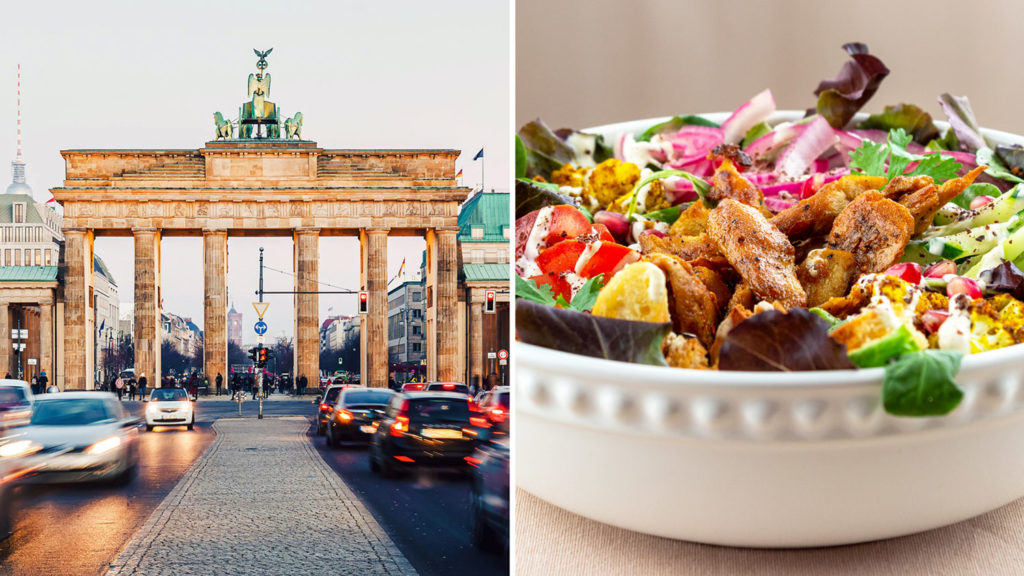Walk in any direction around Berlin, and it won’t be long before you come across a place selling döner kebab—or at least the Berlin version of the traditional Turkish food, which is seasoned meat (normally beef and/or veal) sliced from a rotating, vertical skewer. To put a number to it, there are over 1,000 places selling döner kebab in the city according to Berlin’s tourism website.
The Berlin döner kebab is thinly sliced meat served in thick, triangular-shaped bread with lettuce, tomatoes, cucumbers, onions, red cabbage, and sauce—your choice among garlic, herb, or spicy. There’s some debate surrounding the origin of this portable sandwich interpretation of the kebab dish. The Turkish Association of Döner Manufacturers in Europe says it was invented by Kadir Nurman in Berlin in 1972. Meanwhile, others have also staked their claim, including Mehmet Aygün, who’s known for the Hasir restaurant empire in Berlin and said he created it in 1971, and Nevzat Salim, who said he served the first in Reutlingen in 1969.
While the origin story is murky, what is known is that thousands of guest-workers from Turkey came to West Germany in the 1960s after an agreement was signed between the two countries to help with the latter’s labor shortage. The largest group of guest workers in West Germany, they brought their food culture and many turned to hospitality, adapting based on the ingredients available, market prices, and consumer demands. Today, Turks are the largest ethnic minority group in Germany, and the country is said to have the largest Turkish community outside of Turkey.
Making a vegan döner kebab
Per Meurling, the blogger behind Berlin Food Stories, says the döner kebab’s history is why the dish truly embodies Berlin. “It’s, of course, a construct of an immigrant cuisine, and that’s why it’s really something which stands for Berlin, where a lot of the food, essentially all the food, is immigrant-based,” Meurling says. “The döner is the prime example of how an immigrant dish was adapted to local requirements, local taste, and purchase power to suit the local demand.” Having spent over a decade trying over 100 different versions of döner kebab across the city, he says locals love the dish because it’s readily available, cheap, and filling. Adapting it to a plant-based diet is just another way the versatile dish serves the evolving food culture of Germany.
One major evolution in Berlin’s döner kebab scene occurred when Mustafa Demir started selling a variation made with chicken in the late 1990s. It has since gained cult-like status at the world-famous Mustafa’s Gemüse Kebap. Another development? Vegan versions of the meat-centric street food. The first vegan döner kebab in Germany is credited to Holger Frerichs, who launched the Vöner brand. Frerichs created the recipe using seitan and his own spice mixture, debuting the dish at Fusion Festival in the early 2000s. “People were amazed,” Frerichs says. “I was afraid that maybe they would just laugh about it and think it’s like a joke, but in the end, the recipe was so good.” Inspired by the positive reaction, he decided to found the Vöner shop in Berlin, officially opening in 2007 and tweaking the recipe over the next few years.
Sascha Beyer started working at Vöner in 2008 and now co-owns the restaurant with Kai Kampmann. He thinks that what sets them apart is the ingredients they use: a mixture of seitan, vegetables, chickpeas, soy milk, and soy granules. “When Holger worked on the recipe, there wasn’t any other vegan kebab he could orientate himself by,” Beyer explains. “Also, he didn’t try to mimic real meat but created his own thing.” According to Beyer, the restaurant sells about five to six times as much as they did in the beginning.
As demand rises, more vegan döners are popping up on menus across the city. Vamos Veganos launched their version of a vegan kebab, called the Fiöner, in March 2020. It’s named after Fiona Pampuch, the owner of Vamos Veganos, who would eat so much döner as a kid that her sister gave her the nickname Fiöner. Pampuch says, “One important thing for me is that people still feel light after a döner because mostly people having a döner feel super heavy and tired after.” Rather than using seitan, Pampuch makes her version with tofu and self-made spice mix, and creates a homemade sauce with fresh herbs.
How to make a Vegan Döner Kebab
If you’d like to try to make a vegan döner kebab, try out the recipe below created by Chef Pauline Bossdorf, using LikeMeat’s 100% plant-based Like Kebab, which is made with soybeans. After all, the döner kebab is about adaptation, and there’s always room for more interpretations of the beloved dish.


